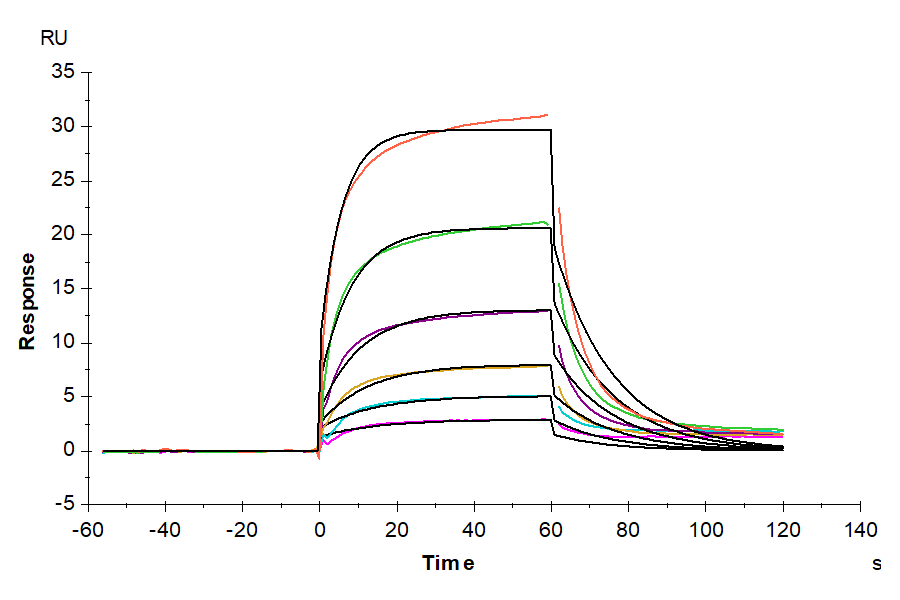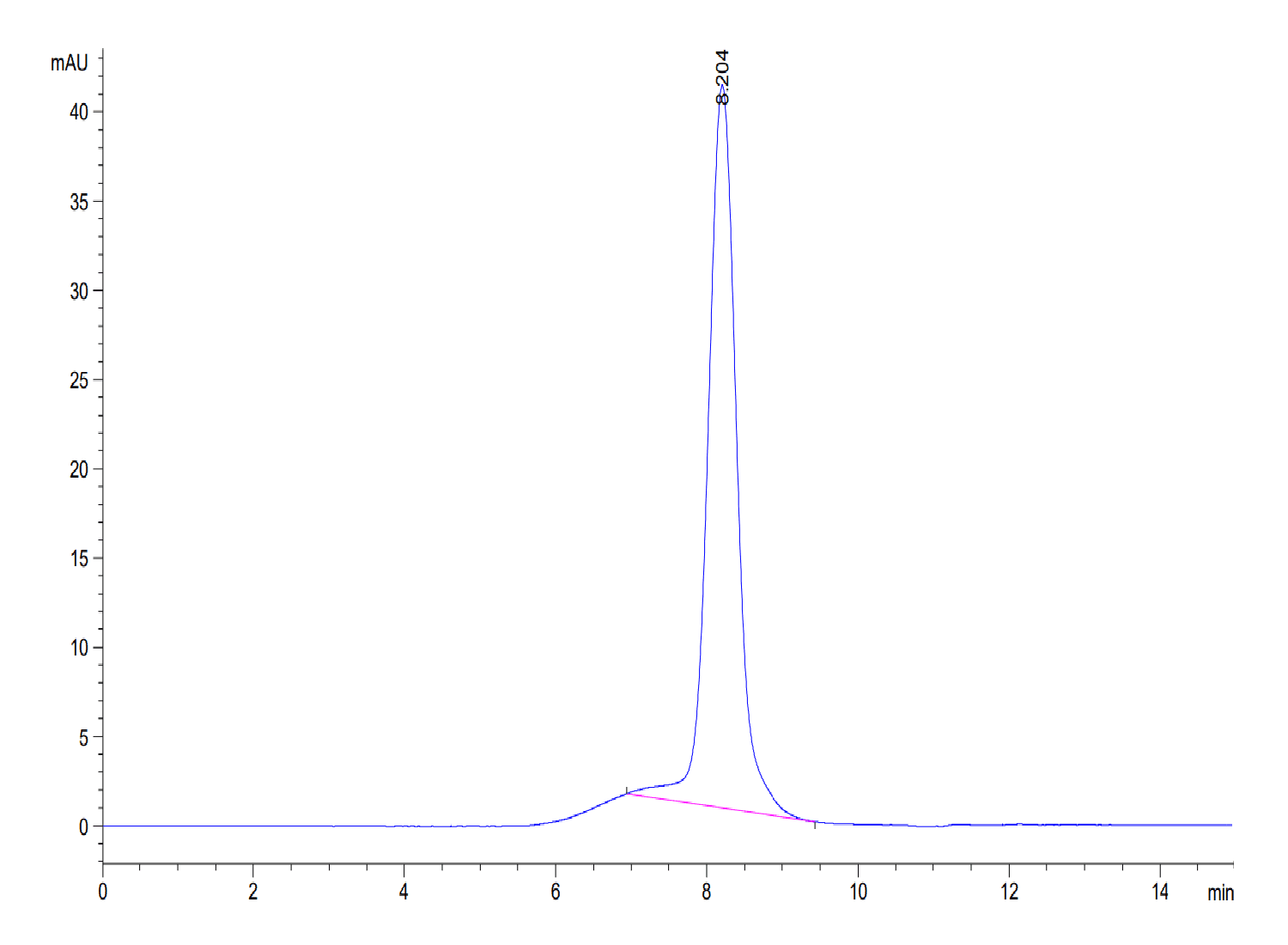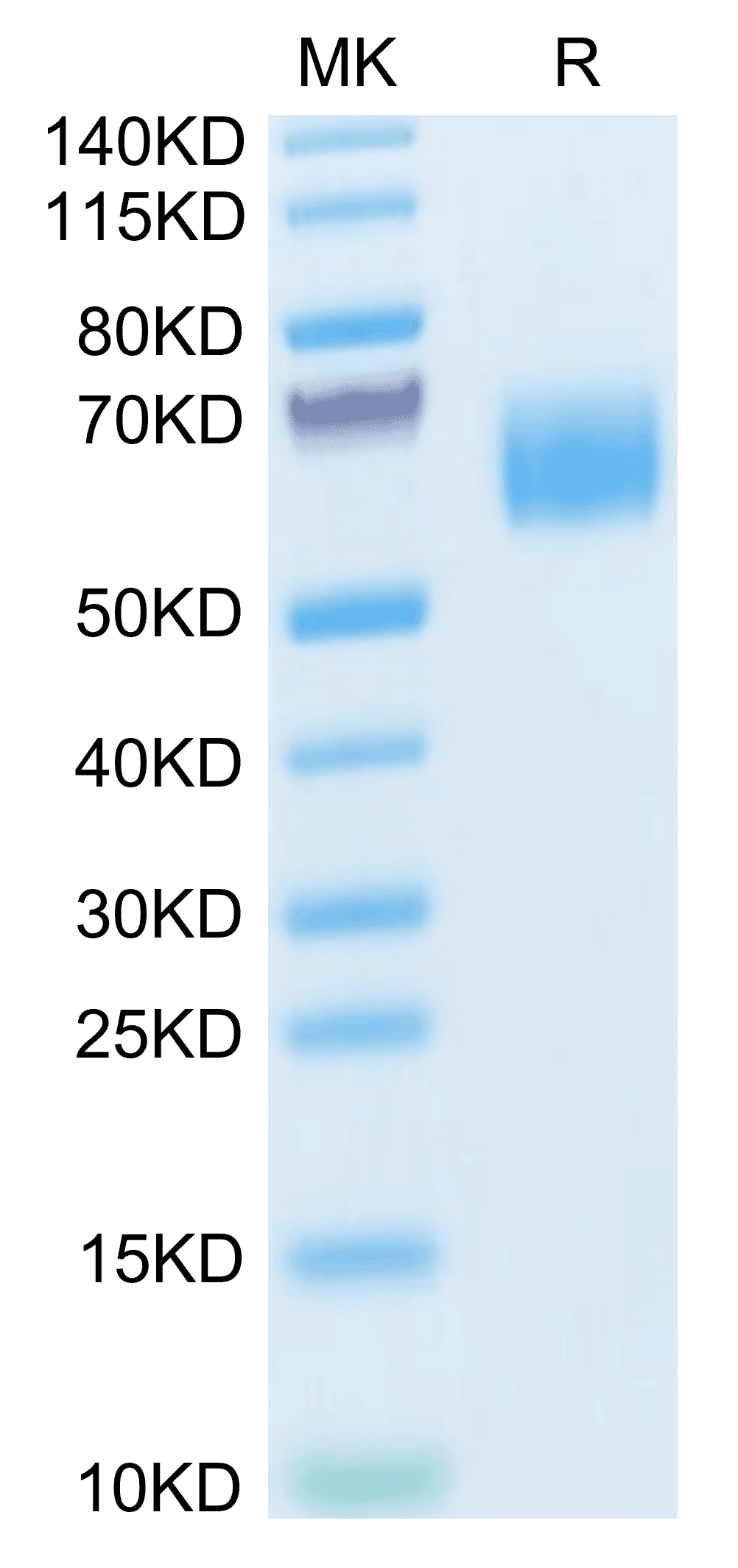| Weight | 1 lbs |
|---|---|
| Dimensions | 9 × 5 × 2 in |
| accession | Q06418 |
| express system | HEK293 |
| product tag | C-His |
| purity | > 95% as determined by Tris-Bis PAGE;> 95% as determined by HPLC |
| background | The TAM receptors (Tyro3, Axl and MerTK) are promising therapeutic targets on tumor-associated macrophages. The TAM receptors are a family of receptor tyrosine kinases with shared ligands Gas6 and Protein S that skew macrophage polarization towards a pro-tumor M2-like phenotype.In macrophages, the TAM receptors also promote apoptotic cell clearance, a tumor-promoting process called efferocytosis. The TAM receptors bind the "eat-me" signal phosphatidylserine on apoptotic cell membranes using Gas6 and Protein S as bridging ligands. |
| molecular weight | The protein has a predicted MW of 42.8 kDa. Due to glycosylation, the protein migrates to 60-70 kDa based on Tris-Bis PAGE result. |
| available size | 100 µg, 500 µg |
| endotoxin | Less than 1EU per μg by the LAL method. |
Human TYRO3 Protein 3855
$150.00 – $500.00
Summary
- Expression: HEK293
- Binding assay: Yes (SPR)
- Amino Acid Range: Ala41-Trp429
Human TYRO3 Protein 3855
| protein |
|---|
| Size and concentration 100, 500µg and lyophilized |
| Form Lyophilized |
| Storage Instructions Valid for 12 months from date of receipt when stored at -80°C. Recommend to aliquot the protein into smaller quantities for optimal storage. Please minimize freeze-thaw cycles. |
| Storage buffer Shipped at ambient temperature. |
| Purity > 95% as determined by Tris-Bis PAGE |
| target relevance |
|---|
| The TAM receptors (Tyro3, Axl and MerTK) are promising therapeutic targets on tumor-associated macrophages. The TAM receptors are a family of receptor tyrosine kinases with shared ligands Gas6 and Protein S that skew macrophage polarization towards a pro-tumor M2-like phenotype.In macrophages, the TAM receptors also promote apoptotic cell clearance, a tumor-promoting process called efferocytosis. The TAM receptors bind the "eat-me" signal phosphatidylserine on apoptotic cell membranes using Gas6 and Protein S as bridging ligands. |
| Protein names Tyrosine-protein kinase receptor TYRO3 (EC 2.7.10.1) (Tyrosine-protein kinase BYK) (Tyrosine-protein kinase DTK) (Tyrosine-protein kinase RSE) (Tyrosine-protein kinase SKY) (Tyrosine-protein kinase TIF) |
| Gene names TYRO3,TYRO3 BYK DTK RSE SKY TIF |
| Protein family Protein kinase superfamily, Tyr protein kinase family, AXL/UFO subfamily |
| Mass 9606Da |
| Function Receptor tyrosine kinase that transduces signals from the extracellular matrix into the cytoplasm by binding to several ligands including TULP1 or GAS6. Regulates many physiological processes including cell survival, migration and differentiation. Ligand binding at the cell surface induces dimerization and autophosphorylation of TYRO3 on its intracellular domain that provides docking sites for downstream signaling molecules. Following activation by ligand, interacts with PIK3R1 and thereby enhances PI3-kinase activity. Activates the AKT survival pathway, including nuclear translocation of NF-kappa-B and up-regulation of transcription of NF-kappa-B-regulated genes. TYRO3 signaling plays a role in various processes such as neuron protection from excitotoxic injury, platelet aggregation and cytoskeleton reorganization. Also plays an important role in inhibition of Toll-like receptors (TLRs)-mediated innate immune response by activating STAT1, which selectively induces production of suppressors of cytokine signaling SOCS1 and SOCS3.; (Microbial infection) Acts as a receptor for lassa virus and lymphocytic choriomeningitis virus, possibly through GAS6 binding to phosphatidyl-serine at the surface of virion envelope.; (Microbial infection) Acts as a receptor for Ebolavirus, possibly through GAS6 binding to phosphatidyl-serine at the surface of virion envelope. |
| Catalytic activity BINDING 524..532; /ligand="ATP"; /ligand_id="ChEBI:CHEBI:30616"; /evidence="ECO:0000255|PROSITE-ProRule:PRU00159"; BINDING 550; /ligand="ATP"; /ligand_id="ChEBI:CHEBI:30616"; /evidence="ECO:0000255|PROSITE-ProRule:PRU00159" |
| Subellular location Cell membrane; Single-pass type I membrane protein. |
| Tissues Abundant in the brain and lower levels in other tissues. |
| Structure Monomer and homodimer. Interacts (via N-terminus) with extracellular ligands TULP1 and GAS6 (By similarity). Interacts with PIK3R1; this interaction increases PI3-kinase activity (By similarity). |
| Post-translational modification Autophosphorylated. |
| Target Relevance information above includes information from UniProt accession: Q06418 |
| The UniProt Consortium |
Data
Publications
Publications
| pmid | title | authors | citation |
|---|---|---|---|
| We haven't added any publications to our database yet. | |||
Protocols
| relevant to this product |
|---|
Documents
| # | ||
|---|---|---|
| Please enter your product and batch number here to retrieve product datasheet, SDS, and QC information. | ||

















